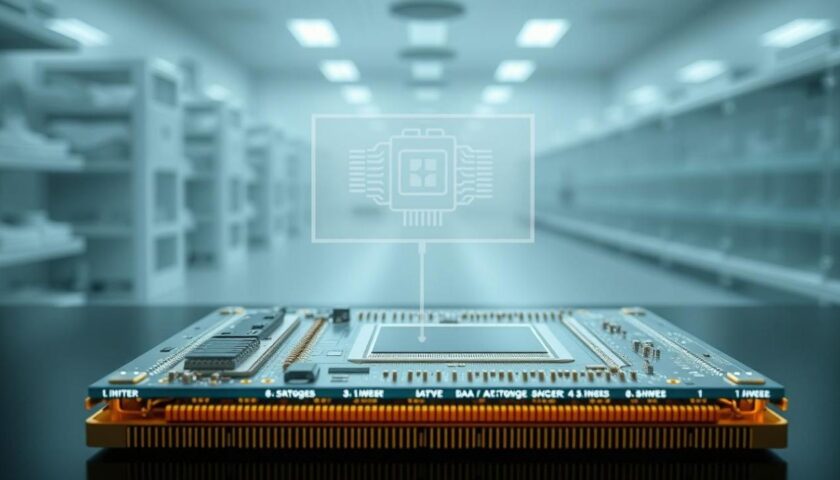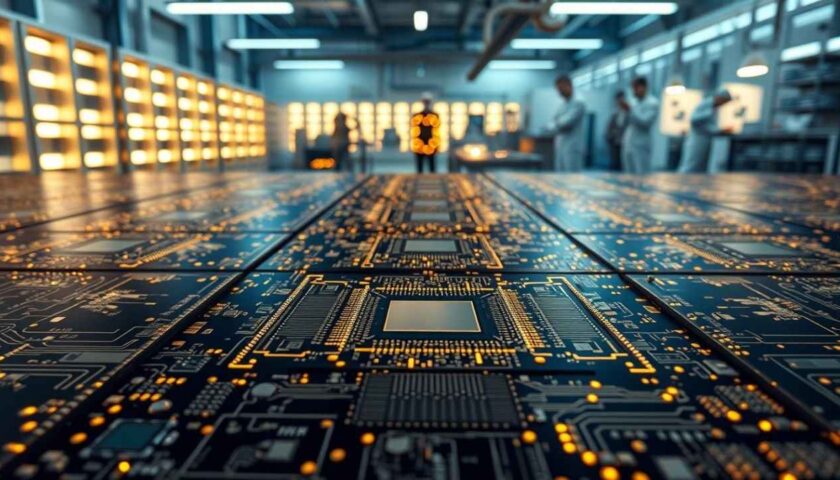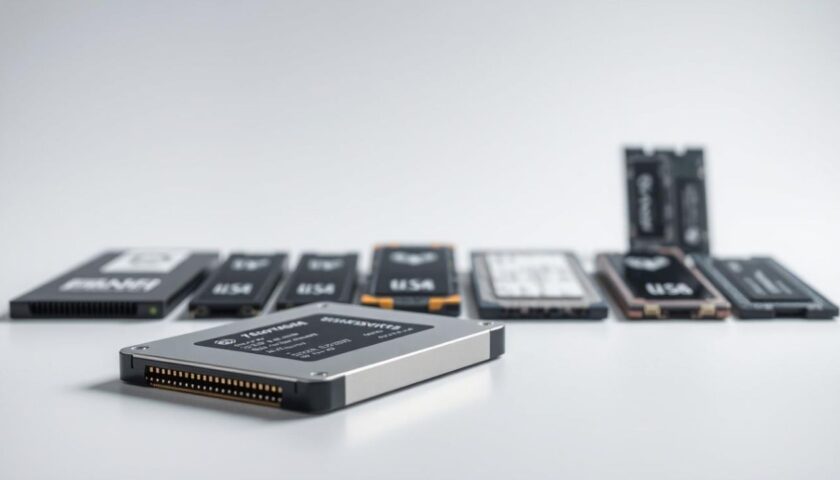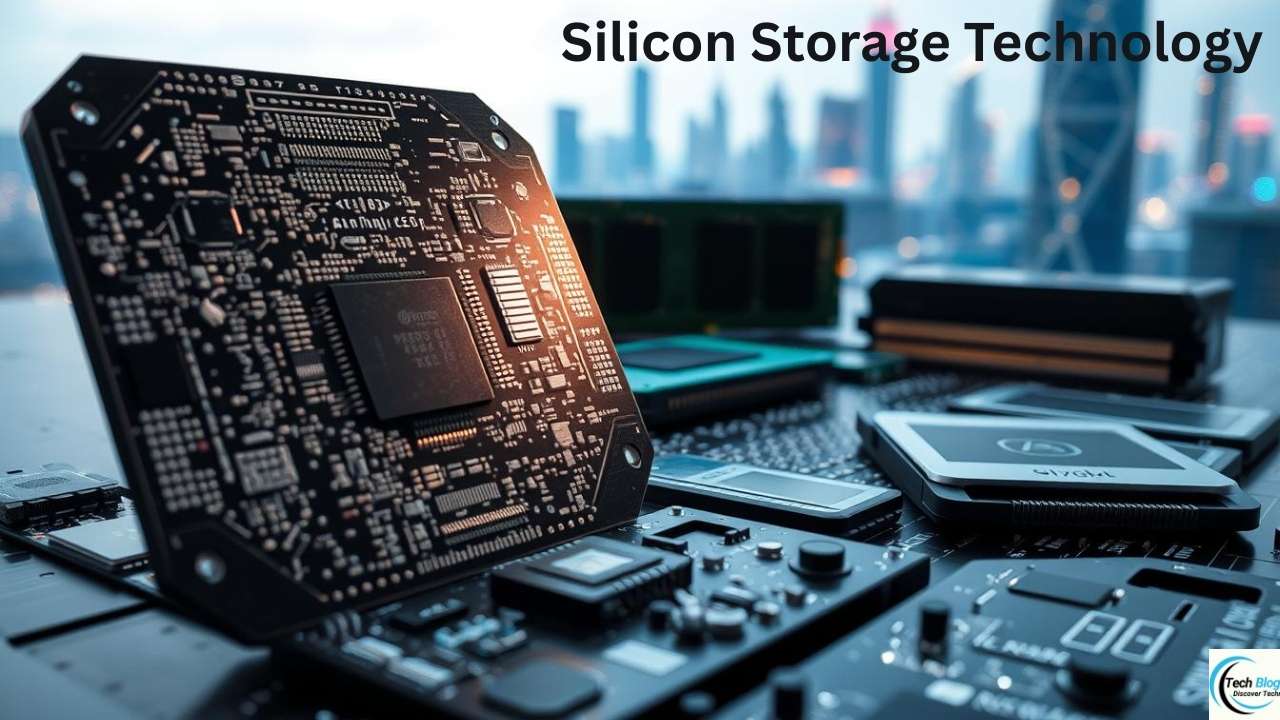The world of data storage is undergoing a major transformation, driven by rapid advancements in Silicon Storage Technology. As the demand for digital data continues to grow, the need for faster, more efficient, and larger storage solutions is becoming increasingly important. This technology is paving the way for a future where data management is smarter and more reliable.
Silicon storage technology is leading this change. It introduces new methods for storing data. The industry is moving toward smarter solutions to handle the vast amount of data we create every day.
This article explores the latest developments in silicon technology. We’ll see how these advancements will change data storage in the future.
Table of Contents
The Evolution of Data Storage: From Magnetic Tapes to Silicon
Data storage has undergone significant changes over the years. It has moved from magnetic tapes to silicon-based storage. This journey has been amazing.
The Historical Journey of Storage Technologies
Early Storage Methods and Their Limitations
Magnetic tapes were the first to store data. They were better than old methods but had some big drawbacks. They could only access data one way and were prone to data loss.
The Transition to Digital Storage
Digital storage emerged next, significantly enhancing data access speed. It also allowed for more data to be stored. This change led to even better storage technologies.

Why Silicon Has Become a Game-Changer
Silicon storage has revolutionized the field of data storage. It’s fast, efficient, and reliable. Solid-state drives (SSDs) are now more popular than old storage methods.
Using silicon in data storage is a big step forward. It offers a strong and growing solution for today’s computers.
What is Silicon Storage Technology?
Silicon storage technology is a game-changer in how we store data. It works at the atomic level, making it incredibly efficient and powerful. Silicon’s unique properties enable the creation of top-notch storage solutions.
The Science Behind Silicon-Based Storage
Silicon-based storage uses silicon’s unique qualities. Silicon can control electrical current, making it perfect for storing data.
Semiconductor Properties of Silicon
Silicon’s properties make it great for microelectronic devices. It enables the creation of complex circuits that accurately store and retrieve data. The industry has mastered silicon manipulation at the atomic level, leading to the development of new storage technologies.
How Data is Stored at the Atomic Level
Storing data at the atomic level means working with individual atoms. Silicon storage uses quantum dots and nanostructures to do this. It’s a method for storing data densely and reliably.

Key Components and Architecture
Silicon storage solutions comprise several key components. These include memory cells, control circuitry, and interface logic. They work together for fast data storage and retrieval.
The design aims to reduce latency and boost throughput. This makes silicon storage suitable for a wide range of applications, from smartphones to data centers.
The architecture is also scalable. This means devices can get bigger as technology improves. Scalability is key for meeting growing data storage needs.
Types of Silicon Storage Solutions in Today’s Market
Today, we have numerous silicon storage solutions to meet various needs. The tech has evolved, leading to various products with unique benefits.
Solid-State Drives (SSDs)
Solid-state drives (SSDs) are known for their fast data access and low latency. They are popular in both personal and business use.
Consumer-Grade vs. Enterprise SSDs
Consumer-grade SSDs are designed for personal use, striking a balance between cost and performance. Enterprise SSDs are designed for heavy use, offering greater endurance and reliability.
Form Factors and Interfaces
SSDs come in various shapes, including 2.5-inch, M.2, and mSATA. They utilize interfaces such as SATA, PCIe, and NVMe. The choice depends on the application’s needs.

3D NAND Flash Memory
3D NAND flash memory stacks cells in three dimensions. It increases storage density and capacity. This tech makes high-capacity SSDs more affordable.
Silicon Photonics Storage
Silicon photonics storage uses light for data transfer. It promises faster speeds and less power use. This tech could change data centers and high-performance computing.
Today’s silicon storage solutions cater to diverse needs. Whether for personal use, business, or new tech, there’s a suitable option.
The Revolutionary Benefits of Silicon Storage Technology
Silicon storage technology represents a significant advancement in data storage. It offers faster speeds, improved efficiency, and enhanced reliability. This technology is changing how we use data.
Speed and Performance Advantages
One key benefit is its speed. Silicon storage enables users to access their data more quickly. This means faster video editing, better gaming, and more efficient data analysis.
Energy Efficiency and Sustainability
It’s also great for saving energy and being green. Silicon storage uses less power, which reduces carbon emissions. This helps the planet and saves companies money.
Reliability and Durability Factors
It’s also very reliable and durable. Silicon storage can handle a lot of use without breaking down. It’s ideal for critical tasks where data security is paramount.
In short, silicon storage technology has many benefits. It enables faster data access, consumes less energy, and is highly reliable. As it continues to improve, we’ll see even more innovative uses for it.
Overcoming Technical Challenges in Silicon Storage
As silicon storage technology improves, it encounters several hurdles. These include density limits, heat issues, and cost. All these need fixing to reach their full promise.
Addressing Density Limitations
Density is a big problem in silicon storage. Making devices smaller while keeping them fast is hard. Scientists are exploring 3D stacking to enhance storage capacity.
Managing Heat Generation and Dissipation
Heat is a significant issue in silicon storage, particularly in fast applications. New cooling methods and designs are being worked on. They aim to keep devices cool and running smoothly.
Cost Considerations and Solutions
Cost is a significant barrier to silicon storage. Ways to cut costs include producing more devices at once and improving the manufacturing process. New packaging ideas are also being tried.
By addressing these issues, silicon storage can continue to improve. It will offer faster, more reliable, and cheaper storage. This is key for handling more data and new tech.
Silicon Storage vs. Traditional Storage Methods
The world of data storage is undergoing rapid change. Silicon storage is now a significant competitor to traditional methods. We’ll examine how silicon storage and traditional methods differ in terms of performance, lifespan, and cost.
Performance Comparison with HDDs
Silicon storage beats traditional hard disk drives (HDDs) in many ways. Solid-state drives (SSDs), a type of silicon storage, are much faster. They offer quicker data access and higher speeds.
Speed and Access Time Differences
Silicon storage is way faster than HDDs. It uses flash memory, not mechanical parts. This means data is stored and retrieved much quicker. You’ll see faster boot times, file transfers, and app loading.
Longevity and Failure Rates
Silicon storage lasts longer than HDDs. It has no moving parts, so it’s less likely to break. This means less chance of losing data due to physical damage. Additionally, silicon storage fails less frequently than HDDs, which tend to wear out over time.
Cost-Benefit Analysis for Businesses and Consumers
Thinking about silicon storage? Businesses and consumers need to look at the costs and benefits. Silicon storage is pricier per gigabyte than HDDs. But it offers better performance and reliability.
For businesses, the benefits are clear. Better performance and reduced data loss lead to increased productivity and savings. For consumers, the faster data access is worth the cost. It’s great for tasks that need quick data processing.
Cutting-Edge Innovations in Silicon Storage
New technologies are changing silicon storage, making it faster and more efficient. Silicon storage is now working in conjunction with new computing concepts. This opens up new ways to process and store data.
Quantum Computing Storage Applications
Quantum computing is revolutionizing the way we solve complex problems. Silicon storage is key in this new field. It requires specialized storage to meet the unique needs of quantum computing, such as maintaining qubit stability and transferring data efficiently.
Neuromorphic Computing Storage Solutions
Neuromorphic computing is akin to the human brain, and silicon storage plays a significant role. It’s made to process information like the brain, in a parallel and efficient way. This requires new storage designs that support the development of complex neural networks.
DNA-Silicon Hybrid Storage Research
DNA-silicon hybrid storage is a combination of biological and silicon technologies. Researchers are exploring the use of DNA with silicon for storage. It could lead to very dense data storage and new methods for keeping data safe for an extended period.
These new ideas in silicon storage are changing how we store data. They’re opening up new uses and possibilities. As research continues, we’ll see even more exciting developments in silicon storage.
How Silicon Storage is Transforming Industries
Silicon storage technology is changing many industries. It offers faster, more efficient, and reliable data storage. This change is seen in many areas, where silicon storage meets specific needs and challenges.
Impact on Cloud Computing and Data Centers
Cloud computing and data centers are improving thanks to advancements in silicon storage. It enables faster data processing, reduces latency, and enhances scalability. This makes it key for modern data centers.
With silicon storage, cloud providers can offer better services. This includes faster data access and higher reliability. It leads to happier customers.
Revolutionizing Mobile and IoT Devices
Mobile devices and IoT technology need compact, efficient storage. Silicon storage offers high-capacity, low-power storage solutions. This enables mobile devices to do more, and IoT devices to work more effectively.
This change is driving new ideas in mobile and IoT. It enables the creation of new apps and services, thanks to improved storage.
Advancements in Healthcare and Scientific Research
In healthcare and scientific research, silicon storage plays a crucial role. It helps store and analyze large amounts of data. This is very important in genomics and medical imaging.
With silicon storage, researchers and healthcare professionals can work more efficiently. This leads to new discoveries and better patient care.
The Future Landscape of Silicon Storage Technology
The world of silicon storage is undergoing rapid change. New technologies and methods are being developed to handle increasingly large amounts of data. The industry is seeking ways to enhance the storage, access, and management of data.
Emerging Trends and Predictions
New trends are shaping the future of silicon storage. Advances in materials science and computing are making storage better. These changes will help us store more data faster and more efficiently.
Next-Generation Materials and Designs
Scientists are developing new materials and designs for silicon-based storage. They’re using phase-change materials and nanostructures to boost storage density and speed.
Scaling Challenges and Solutions
As silicon storage capacity grows, making it faster and cheaper becomes increasingly challenging. To solve this, companies are finding new ways to make storage. They’re utilizing advanced manufacturing and innovative memory designs to meet the increasing demands for data.
The Role of AI in Advancing Silicon Storage
Artificial intelligence (AI) is becoming more important in silicon storage. AI helps enhance storage systems, predicts when they require maintenance, and improves data management. AI helps the industry create storage solutions that are efficient, reliable, and scalable to meet our evolving needs.
Conclusion: Embracing the Silicon Storage Revolution
The future of data storage is changing thanks to the silicon storage revolution. This new tech promises to change how we store and manage data. Silicon storage offers numerous benefits, including faster speeds, improved energy efficiency, and enhanced reliability.
By adopting silicon storage, businesses and people can explore new data uses. Silicon storage can be utilized in various areas, including cloud computing, data centers, and mobile and IoT devices.
Looking ahead, silicon storage will be crucial in the future of data storage. It offers faster, more efficient, and reliable storage. By keeping up with this technology, we can fully harness the power of the silicon storage revolution.
FAQ
What is silicon storage technology?
Silicon storage technology uses silicon to store digital data. It has changed how we store data, making it faster and more reliable.
How does silicon storage compare to traditional storage methods?
Silicon storage, such as SSDs, is significantly faster than traditional hard drives. It has quicker access times and is more reliable.
What are the different types of silicon storage solutions available?
There are many silicon storage options, like SSDs and 3D NAND flash memory. Each has its own benefits for different needs.
How is silicon storage technology being used in emerging applications?
Silicon storage is key in emerging areas such as quantum computing and DNA storage. It’s helping us explore new possibilities for data storage.
What is the future of silicon storage technology?
The future of silicon storage looks bright. New materials and AI will make it even faster and more reliable.
What are the challenges facing the adoption of silicon storage technology?
While silicon storage is beneficial, it also presents challenges. Cost, density, and heat are issues. But researchers are working to solve these problems.


